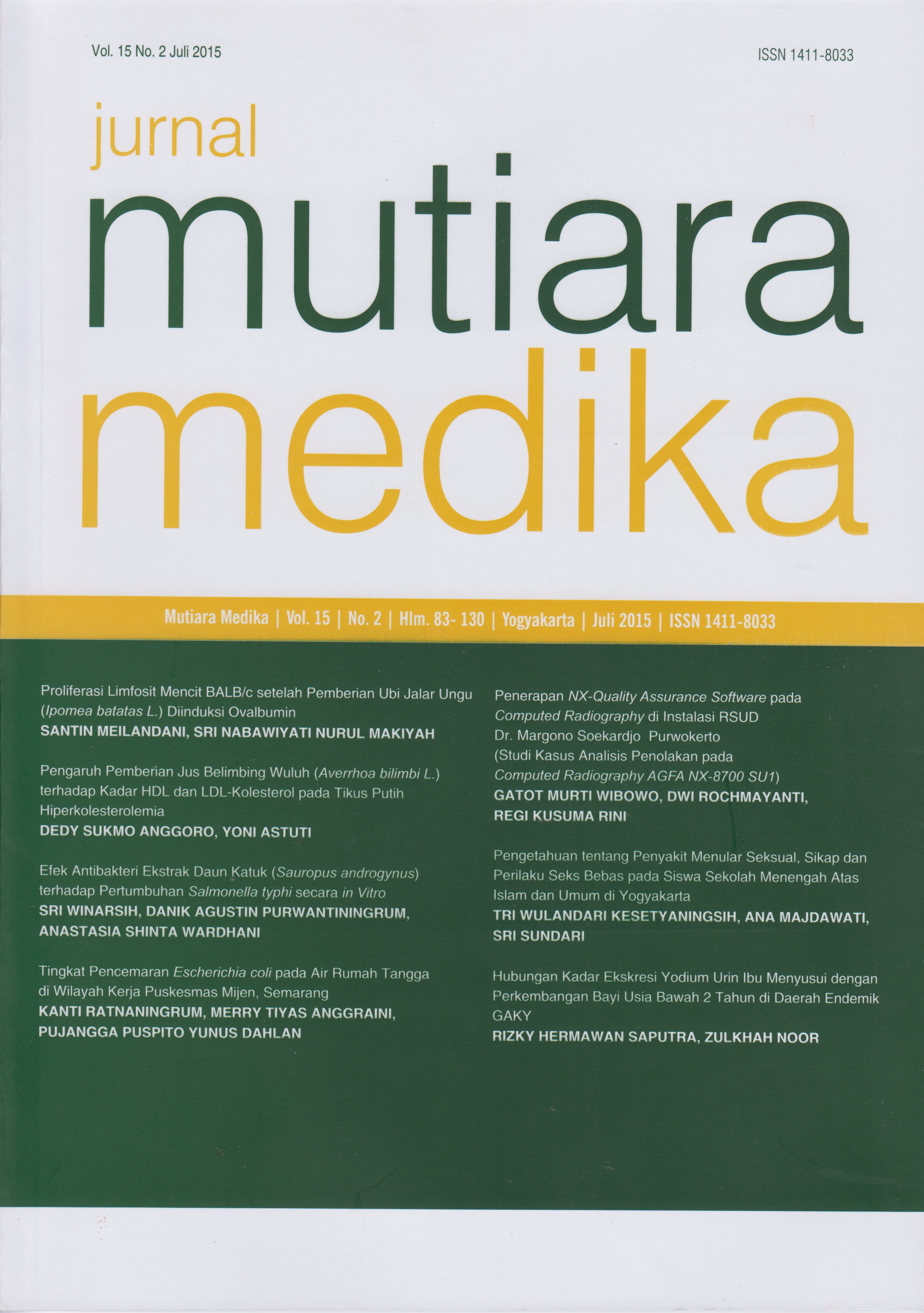Tingkat Pencemaran Escherichia coli pada Air Rumah Tangga di Wilayah Kerja Puskesmas Mijen, Semarang
DOI:
https://doi.org/10.18196/mmjkk.v15i2.3756Keywords:
Escherichia coli, households water pollution, diarrhea, pencemaran air rumah tangga, diareAbstract
urangnya ketersediaan air bersih menimbulkan penyakit gangguan saluran pencernaan seperti diare. Sebagian besar bakteri penyebab diare adalah Escherichia coli. Insidensi diare dinilai masih jauh dari capaian target Puskesmas Mijen, Semarang. sehingga diperlukan penelitian tentang kontaminasi E. coli pada air rumah tangga di wilayah kerja Puskesmas. Penelitian ini bersifat observasional dengan rancangan cross sectional. Sampel ditentukan dengan metode systematic random sampling dengan estimasi proporsi. Sampel diambil dari 10 kelurahan yang masuk dalam wilayah kerja. Kadar bakteri E. coli dalam air rumah tangga dilakukan di dengan metode most probable number (MPN). Terkumpul 36 sampel yang berasal dari 3 jenis sumber air yaitu sumur gali, sumur artesis dan perusahaan air minum (PAM). Uji laboratorium menunjukkan bahwa 55,6 % sampel air minum telah memenuhi nilai uji bakteriologis E. coli. Air berasal dari sumur gali memiliki tingkat kontaminasi paling tinggi (100%) diikuti sumur artesis (34,61%) dan PAM bebas dari E. coli (0%).Lack of clean water supply causes gastrointestinal disorders such as diarrhea. Most of the bacteria that cause diarrhea are Escherichia coli. The incidence of diarrhea is still far from the target of Mijen Puskesmas, Semarang, so research on E. coli contamination on household water in Puskesmas work areas is needed. This research was observational with cross sectional design. The sample is determined by systematic random sampling method with estimated proportion. Samples were taken from 10 urban villages included in the work area. E. coli bacteria levels in household water are carried out in the most probable number (MPN) method. Collected 36 samples derived from 3 types of water sources ie dug wells, artesian wells and drinking water companies (PAM). Laboratory tests showed that 55.6% of drinking water samples had met the bacteriological test value of E. coli. Water derived from dug wells has the highest contamination rate (100%) followed by artesian well (34.61%) and PAM free from E. coli (0%).
References
Notoatmodjo S. Penyediaan Air Bersih dalam Kesehatan Masyarakat Ilmu dan Seni. 2007. Jakarta: Rieka Cipta.. Halm. 172-180.
Entjang I. Ilmu Kesehatan Masyarakat. Bandung: Citra aditya bakti, 74-78.
Kementrian Kesehatan Republik Indonesia. Peraturan Menteri Kesehatan Nomor 492 / Menkes / Per / IV / 2010 tentang Persyaratan Kualitas Air Minum. 2010.
Mubarak WI, Chayatin N. Ilmu Kesehatan Masyarakat Teori dan Aplikasi. 2009. Jakarta: Salemba Medika, 289-309.
Astuti MT, Rahdriawan M. 2013. Evaluasi Pengelolaan Program Pamsimas di Lingkungan Permukiman Kecamatan Mijen, Semarang. Jurnal Teknik PWK, 2013; 2 (4): 938-947.
Perusahaan Daerah Air Minum Tirto Moedal Semarang. Proses Pengolahan Air. 2014. http://www.pdamkotasmg.co.id
Downloads
Issue
Section
License
Copyright
Authors retain copyright and grant Mutiara Medika: Jurnal Kedokteran dan Kesehatan (MMJKK) the right of first publication with the work simultaneously licensed under an Attribution 4.0 International (CC BY 4.0) that allows others to remix, adapt and build upon the work with an acknowledgment of the work's authorship and of the initial publication in Mutiara Medika: Jurnal Kedokteran dan Kesehatan (MMJKK).
Authors are permitted to copy and redistribute the journal's published version of the work (e.g., post it to an institutional repository or publish it in a book), with an acknowledgment of its initial publication in Mutiara Medika: Jurnal Kedokteran dan Kesehatan (MMJKK).
License
Articles published in the Mutiara Medika: Jurnal Kedokteran dan Kesehatan (MMJKK) are licensed under an Attribution 4.0 International (CC BY 4.0) license. You are free to:
- Share — copy and redistribute the material in any medium or format.
- Adapt — remix, transform, and build upon the material for any purpose, even commercially.
This license is acceptable for Free Cultural Works. The licensor cannot revoke these freedoms as long as you follow the license terms. Under the following terms:
Attribution — You must give appropriate credit, provide a link to the license, and indicate if changes were made. You may do so in any reasonable manner, but not in any way that suggests the licensor endorses you or your use.
- No additional restrictions — You may not apply legal terms or technological measures that legally restrict others from doing anything the license permits.






